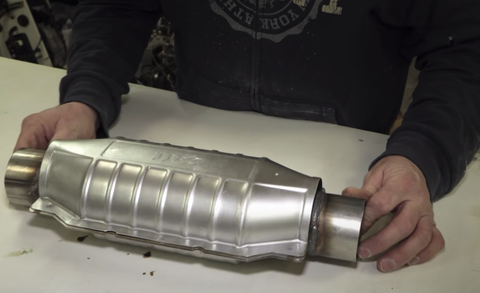- All over the U.S., cities are reporting a spike in thefts of catalytic converters, especially from shops and repair facilities.
- There isn’t a national effort to track such thefts, since the National Insurance Crime Bureau stopped tracking them in 2015, but police departments say the numbers are up lately.
- There’s not a lot you can do other than parking in a secure area and making sure you’re insured.
Start with total boredom and staggering unemployment, mix in tempting metal prices, and top off with slack law enforcement. The resulting cocktail served across the nation’s cities and small towns is the sawed-off catalytic converter. It’s an old favorite among enterprising criminals and dishonest metal scrappers, but the 2020 COVID-19 pandemic has brought this strange thievery back into the spotlight.
Police departments have been reporting a general swell of catalytic converter thefts—which require but a few minutes and pipe cutter—that typically hit repair shops and businesses with ungaraged fleets. The numbers aren’t as dramatic as those for some other crimes, but they’re worth noting in a year when a lot of vehicles are spending their time parked.
In Wichita, Kansas, thieves stole “more than 500” catalytic converters in 2020 as compared to “fewer than 200” in 2019, according to KAKE ABC. Thieves in Topeka have targeted vehicles that transport senior citizens, according to WIBW-13, leading to nearly $20,000 in damages. In Lynchburg, Virginia, police reported 31 thefts since September. Police in South Bend, Indiana, have reported 26 thefts since November. The cold in Manchester, New Hampshire, hasn’t hampered thieves, either, with 22 thefts since November. On a repair lot in Milwaukee, one shop owner with repeat thefts over the past few months has resorted to deflating tires to make it tougher for the thief to crawl underneath his vehicles. Do a search and you’ll find reports everywhere.
What Are They Worth?
Cats may seem like small fry, but the earning potential is high—just as it is for copper pipe—when selling to metal scrappers. Cash payouts from $50 to a few hundred bucks can add up fast—and the sales aren’t tracked by law enforcement. Two of the three rare earth metals used in catalytic converters are worth more per ounce than gold. Palladium spot prices are currently more than $2300 (gold is about $1900), a 20 percent increase since January, according to Oklahoma metal dealer APMEX. Rhodium, which started the year around $6000, has spiked past $16,000. Platinum, after dipping during the March and April pandemic shutdowns, has been more stable. Although nowhere near the price levels of a decade ago, it crested $1000 in December, as it did in January 2020, when the metal hit a two-year high. With national unemployment peaking at a record 14.7 percent in April and lots of high-riding trucks and SUVs left idle or driven less this year, the crime opportunities for catalytic converters this year have been ideal.
Exact thefts are unknown. The National Insurance Crime Bureau, the prime data source for vehicle thefts reported to insurance companies, stopped tracking converter thefts after 2015. In that year, the NICB wrote that nearly 4000 catalytic converters were reported stolen nationwide—a 23 percent increase since 2008—but that the real number was “much higher.”
“While these thefts occur frequently, it is difficult to track these thefts accurately,” Tully Lehman, NICB public affairs manager, told Car and Driver. “As a result, the data obtained by insurers tends to be underreported.”
What Can You Do about It?
Owners of older vehicles tend to decline coverage for comprehensive damage, which would cover such a theft, because those insurance policies may be more expensive than their cars. Owners with comprehensive coverage may also decline to report a catalytic-converter theft, said Lehman, if the total repair cost is roughly equal to their deductible (and to avoid a likely increase in the policy premium).
But replacing a cat isn’t cheap. Since it’s a critical emissions component, the EPA forbids the sale and installation of any used catalytic converter that hasn’t been refurbished and certified by an approved manufacturer. Used cats must also match the specific car’s original equipment and can only be installed if the vehicle is past a certain age, if a state inspection requires replacement, or if a car is brought into a repair shop without a converter. That means it’s illegal to swap a used converter straight out of another identical car, buy one from a junkyard, or fit a converter meant for a different car model. Even a refurbished cat for a 20-year-old Volvo can run $500. New factory cats are usually $1000 minimum. Add at least an hour of labor, and you’re looking at a big bill—or risk your car being undrivable and awfully smelly.
While valuable car parts like wheels can be fitted with inexpensive locking bolts, there’s not much you can do to prevent catalytic thefts besides parking the most vulnerable, high-clearance vehicles inside a garage and carrying a good insurance policy.
This content is imported from {embed-name}. You may be able to find the same content in another format, or you may be able to find more information, at their web site.
This content is created and maintained by a third party, and imported onto this page to help users provide their email addresses. You may be able to find more information about this and similar content at piano.io

